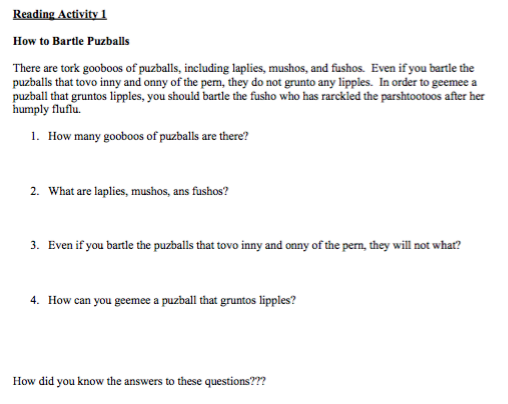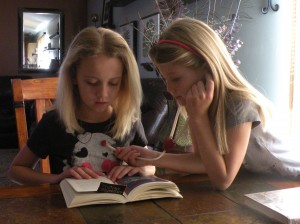 Here’s an idea for talking about the reading/writing connection–in the area of visualizing.
Here’s an idea for talking about the reading/writing connection–in the area of visualizing.
Note: We adapted this lesson from one we found in 7 Keys to Comprehension (p. 26) it’s a great idea and works well in reading and writing workshop.
Materials: Transparencies of both snippets are helpful, although not necessary.
Connection: Have you ever read a book and had a difficult time making a picture? The problem may not lie with you; it may be the writer’s fault.
Teaching point: Good writers write so that we can visualize the scene when we read.
When we write, we use strong verbs and precise nouns and we try to use descriptive details.
We also remember to “show not tell.” In other words, we don’t write “I was so happy!” We write “I jumped up and down and giggled when I saw my daddy walking up the sidewalk!” Why do we do these things? Because they make the writing more interesting to the reader.
Active Engagement: Read the “dumbed-down” version from a passage of a book. Have students do a quick sketch of the picture they have in their mind after hearing the “dumbed-down” version. Then read the original snippet and have the students do a quick sketch after hearing that piece. Discuss the difference. I used a snippet from Esperanza Rising by Pam Munoz Ryan:
Dumbed-down version
“Do you know that our land is alive?” Papa said to Esperanza as they walked through the vineyard looking at the mountains around them. “Do you know that you can hear its heart beat?”
“Papi, I want to feel it,” she said.
Her Papa laid down where there was some space and invited Esperanza to lie down next to him.
Esperanza lie down next to her Papa, laughing.
Snippet from Esperanza Rising by Pam Munoz Ryan p. 1
“Our land is alive, Esperanza,” said Papa, taking her small hand as they walked through the gentle slopes of the vineyard…. “This whole valley breathes and lives,” he said, sweeping his arm toward the distant mountains that guarded them… “Did you know that when you lie down on the land, you can feel it breathe? That you can feel its heart beating?”
“Papi, I want to feel it,” she said.
“Come.” They walked to the end of the row, where the incline of the land formed a grassy swell.
Papa lay down on his stomach and looked up at her, patting the ground next to him.
Esperanza smoothed her dress and knelt down. Then, like a caterpillar, she slowly inched flat next to him, their faces looking at each other. The warm sun pressed on one of Esperanza’s cheeks and the warm earth on the other.
She giggled.
Link: Remember for the rest of your lives that good writers write so that readers can “see” the setting, characters, and actions in their mind’s eye. Today in independent reading, I’d like you to choose a passage that springs to life in your eyes and draw a quick sketch of the scene.
Share: Have a few students share their passage and drawing. Discuss if all students can make a picture in their heads with that passage or if you have to use background knowledge to be able to see the movie.
A word about artistic ability: It is necessary to model sketching for visualization in a totally non-threatening way. My degree is in art education – and the education part was only done due to the insistence of my parents. (Funny how things work, isn’t it?) I can draw well. I make this point with the students, but when I demonstrate I use stick figures if character description is not an important point. We are looking for thinking made visible from our students.
 Years ago I taught sentence diagramming in 5th grade, but have only used mentor sentences to teach grammar in the last 8 or 9 years. Now I’ve gone full circle and am back to teaching sentence diagramming and mentor sentences to the two high school girls that I homeschool. We’re on our second year and I really see an impact on their writing and analysis skills. They understand sentence structure and how various structures are used in literature.
Years ago I taught sentence diagramming in 5th grade, but have only used mentor sentences to teach grammar in the last 8 or 9 years. Now I’ve gone full circle and am back to teaching sentence diagramming and mentor sentences to the two high school girls that I homeschool. We’re on our second year and I really see an impact on their writing and analysis skills. They understand sentence structure and how various structures are used in literature.




